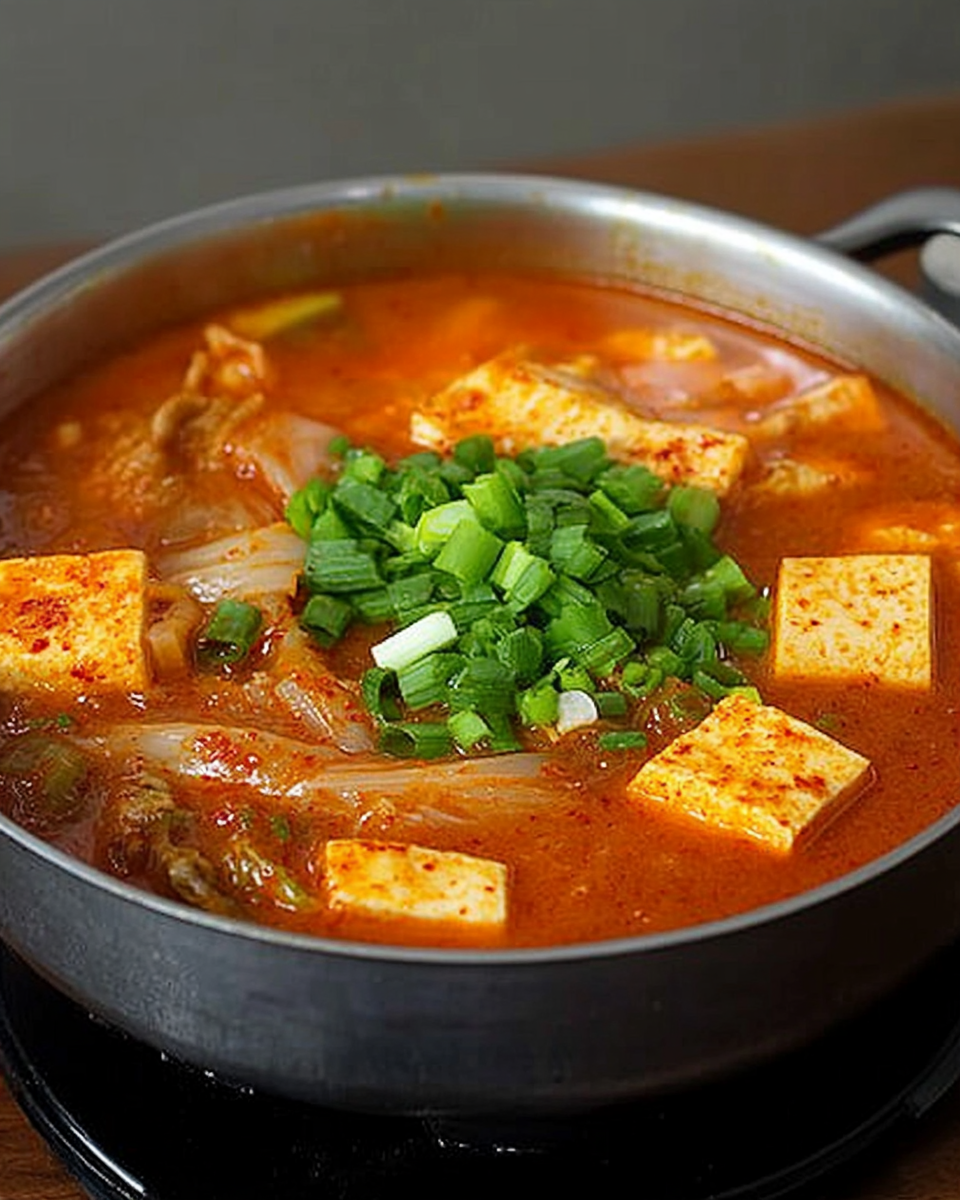Kimchi Jjigae is a comforting Korean stew made with spicy, tangy kimchi that has been simmered to perfection. The addition of tender pork or beef, tofu, and savory broth makes it a heartwarming meal ideal for colder months.
This dish is not only easy to make, but also offers a complex flavor profile, thanks to the rich umami from the kimchi and the heat from the gochujang. Serve it with a bowl of steamed rice to enjoy a full meal that’s comforting and satisfying. Perfect for any day of the week when you need something to warm your soul.
Full recipe:
Ingredients:
-
2 cups of well-fermented kimchi (cut into pieces)
-
1/2 lb (225g) pork belly or beef, sliced thinly (optional)
-
1 medium onion, sliced
-
1/2 block of tofu, cut into cubes
-
1 tablespoon sesame oil
-
2 tablespoons gochujang (Korean chili paste)
-
1 tablespoon gochugaru (Korean red pepper flakes)
-
2 cloves garlic, minced
-
4 cups water or broth
-
2 tablespoons soy sauce
-
1 tablespoon sugar
-
Salt and pepper to taste
-
Green onions, chopped (for garnish)
Directions:
-
Heat a large pot over medium heat and add sesame oil.
-
Add the pork belly or beef, and cook for 3-5 minutes until the meat is browned.
-
Add the garlic and onion, and sauté for another 2-3 minutes until the onion becomes translucent.
-
Add the gochujang and gochugaru to the pot and stir for a minute, allowing the flavors to combine.
-
Pour in the water or broth, soy sauce, and sugar. Stir to combine and bring the mixture to a boil.
-
Once boiling, reduce heat to a simmer and add the kimchi. Let the stew simmer for 20-30 minutes, allowing the flavors to meld.
-
Add the tofu cubes, and cook for an additional 5 minutes.
-
Taste and season with salt and pepper as needed.
-
Serve the stew hot, garnished with chopped green onions.
Prep Time: 10 minutes | Cooking Time: 35 minutes | Total Time: 45 minutes
Kcal: 230 kcal | Servings: 4 servings
The History and Significance of Kimchi Jjigae
Kimchi Jjigae has its roots in Korean cuisine and is considered a classic example of the country’s use of fermented foods. Kimchi, a staple in Korean homes, is made from fermented vegetables, often cabbage or radishes, mixed with chili peppers, garlic, ginger, and other seasonings. The fermentation process not only extends the shelf life of vegetables but also enhances their flavor, creating a tangy, spicy base that’s used in many Korean dishes. When made into a stew, kimchi becomes the star ingredient, adding layers of complexity to the dish.
Kimchi Jjigae is traditionally made with leftover or aged kimchi, which has developed a deeper sourness over time. This is because older kimchi is often considered more flavorful for stews and soups, as its strong, fermented taste infuses the broth. The dish became widely popular due to its simplicity, as it’s quick to make, and its ability to stretch ingredients, which made it a perfect dish for families during times when resources were limited.
In addition to its practical aspects, Kimchi Jjigae carries cultural significance. In Korea, a steaming pot of this stew is often served as a shared dish, bringing people together to enjoy a warm, nourishing meal. It’s common to find Kimchi Jjigae being served as a side dish during a traditional Korean meal, alongside rice and other banchan (small side dishes). The communal aspect of the dish enhances its appeal, as everyone enjoys the same flavorful pot of stew.
Key Ingredients in Kimchi Jjigae
The beauty of Kimchi Jjigae lies in its versatility. The core ingredients remain consistent, but various elements can be added or substituted depending on preferences or available ingredients. The main component is, of course, kimchi, which provides the stew with its signature sourness and spice. The kimchi is usually aged, as it becomes more robust and flavorful over time.
Pork belly or beef are often the meats of choice, though tofu can be used for a vegetarian or vegan option. These proteins lend the stew richness and substance. Pork belly is a favorite because of its fatty richness, which adds depth to the stew’s flavor. However, if you’re looking for a leaner version, beef, particularly beef short ribs, is also a great choice. Some people opt to make Kimchi Jjigae with a combination of both pork and beef for an extra layer of taste.
The addition of tofu not only enhances the texture but also helps to balance the spiciness of the kimchi. Silky tofu works wonderfully to absorb the flavors of the broth, offering a smooth contrast to the crunchiness of the kimchi and the tenderness of the meat. The broth itself is created by simmering all the ingredients together, often flavored with soy sauce, garlic, and gochujang, a Korean chili paste that adds an extra kick to the stew.
Another key ingredient is gochugaru, Korean chili flakes that contribute a smoky, spicy element to the dish. These chili flakes are often used alongside gochujang, which is a paste made from fermented soybeans and red chili peppers. The combination of these two ingredients creates the signature heat and depth of Kimchi Jjigae.
Variations and Customization
One of the great things about Kimchi Jjigae is that it is easily customizable. Depending on regional variations and personal taste, many different ingredients can be added to the stew. Some people include mushrooms, zucchini, or potatoes for added texture and flavor. Others might choose to use a different protein, such as chicken or seafood. The tofu can be substituted with other plant-based proteins, making it suitable for vegan diets.
While the traditional recipe typically uses pork or beef, some variations might feature fish cakes or even seafood, adding a new dimension to the dish. The sweetness of carrots or the earthiness of mushrooms can balance the heat and sourness of the kimchi. Additionally, depending on the level of spiciness desired, the amount of gochujang and gochugaru can be adjusted.
Another way to personalize Kimchi Jjigae is through the broth. While water is the most common base, some people prefer to use chicken or beef broth to add more depth and richness. The flavors can be enhanced further with the addition of fish sauce or miso paste, which are also commonly used in Korean cooking to deepen the umami flavor.
Health Benefits of Kimchi Jjigae
Kimchi Jjigae is not just delicious but also offers numerous health benefits. The star ingredient, kimchi, is rich in probiotics due to its fermentation process. Probiotics are beneficial bacteria that promote a healthy gut, improve digestion, and boost the immune system. Fermented foods like kimchi can help maintain a balanced gut microbiome, which is important for overall health.
The dish also provides a good source of protein, especially if made with meat or tofu. Tofu, being plant-based, offers a heart-healthy protein option that is low in saturated fat. The vegetables in the stew, such as onions and garlic, are packed with vitamins and antioxidants that support health and help to reduce inflammation.
Kimchi Jjigae is naturally low in calories, making it a great option for those looking for a nutritious, filling meal that won’t derail their diet. The ingredients provide a balance of macronutrients—proteins, fats, and carbohydrates—making the dish well-rounded. The use of soy sauce, gochujang, and gochugaru also adds beneficial compounds such as vitamins, minerals, and capsaicin (found in chili peppers), which has been shown to boost metabolism and promote fat loss.
How to Serve Kimchi Jjigae
Kimchi Jjigae is traditionally served with steamed rice, making it a complete meal. The rice helps to neutralize the spiciness of the stew, providing a comforting balance. The stew is often shared among friends or family, with everyone enjoying it directly from the communal pot. If you prefer a milder version of the stew, you can adjust the amount of gochujang and gochugaru or even remove one of these ingredients altogether.
Kimchi Jjigae pairs wonderfully with a variety of side dishes, known as banchan, which are typically served with Korean meals. Common banchan served with Kimchi Jjigae include kimchi (of course), pickled vegetables, stir-fried greens, or even cold noodles. These sides add variety and texture, complementing the bold flavors of the stew.
Conclusion
Kimchi Jjigae is a rich, flavorful dish that showcases the best of Korean comfort food. With its deep umami from the fermented kimchi, hearty meat, and tofu, it’s the perfect stew for cold days or when you need a comforting meal to bring people together. The dish is incredibly versatile, allowing for adjustments to suit different dietary preferences and tastes, while its health benefits make it a nourishing option for all. Whether you’re a fan of Korean cuisine or new to the flavors, Kimchi Jjigae is a must-try recipe that’s sure to become a household favorite.
Kimchi Jjigae is more than just a dish; it’s a part of Korean culinary culture, bringing warmth, comfort, and deliciousness to your table. Whether you serve it with rice or alongside a variety of banchan, Kimchi Jjigae offers an experience that’s as satisfying as it is delicious. Try it today, and you’ll soon discover why it’s one of Korea’s most beloved dishes.






